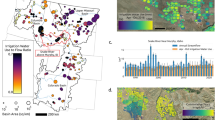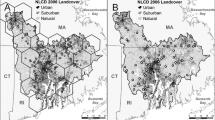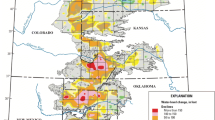Abstract
California’s population increased 25% between 1980 and 1990, resulting in rapid and extensive urbanization. Of a total 123,000 ha urbanized in 42 of the state’s 58 counties between 1984 and 1990, an estimated 13% occurred on irrigated prime farmland, and 48% on wildlands or fallow marginal farmlands. Sixty-six percent of all new irrigated farmland put into production between 1984 and 1990 was of lesser quality than the prime farmland taken out of production by urbanization. Factors dictating the agricultural development of marginal farmlands include the availability and price of water and land, agricultural commodity prices, and technical innovations such as drip irrigation systems that impact the feasibility and costs of production. The increasing amount of marginal farmland being put into production could have significant water quality consequences because marginal lands are generally steeper, have more erodible soils, poorer drainage, and require more fertilizer than prime farmlands. Although no data exist to test our hypothesis, and numerous variables preclude definitive predictions, the evidence suggests that new irrigated marginal lands can increase nonpoint source (NPS) pollution for a given size area by an order of magnitude in some cases.
Similar content being viewed by others
Literature Cited
AFT (American Farmland Trust). 1986. Eroding choices—emerging issues: The condition of California’s agricultural land resources. American Farmland Trust, Davis, California.
Anton, E., J. Barnickol, and D. Schnaible. 1988. Nitrate in drinking water—report to the legislature. California State Water Resources Control Board, Division of Water Quality, Report No. 88-11WQ.
Archibald, E. 1991. Urban drainage as a source of drinking water contamination. Proceedings of the Protecting Drinking Water Quality at the Source Conference, California Water Resources Center Report No. 76. University of California, Riverside, California.
CDF (California Department of Forestry and Fire Protection). 1988. Forest and Rangeland Resources Assessment Program. California’s Forests and Rangelands: Growing Conflict Over Changing Uses, July.
Clark, E. H. 1985. Costs of soil erosion.Journal of Soil and Water Conservation. 40(1):19–22.
DOF (California Department of Finance). 1986. Demographic Research Unit. Projected total population of California counties, Report 86 P-1, December.
DOF (California Department of Finance). 1990. Demographic Research Unit. Ranking of California cities and counties. Report E-8.
DWR (California Department of Water Resources). 1985–1987. San Joaquin District. San Joaquin Valley drainage monitoring program. Annual district reports for calendar years 1985–1987.
DWR (California Department of Water Resources). 1987. California water: Looking to the future. DWR Bulletin 160–87, November.
Ellis, B. G. 1982. Nitrate contamination of groundwater on the Old Mission Peninsula: Contribution of land reshaping and septic drainfields. Michigan State University, March.
EPA (US Environmental Protection Agency). 1983. Final report of the nationwide urban runoff program. Water Planning Division, Washington, D.C., December.
EPA (US Environmental Protection Agency). 1987. Nonpoint source guidance. Office of Water Regulations and Standards, Washington, D.C., December.
EPA (US Environmental Protection Agency). 1992. Managing nonpoint source pollution. Office of Water, Washington, D.C., January.
Goldman, S. J., K. Jackson, and P. A. Bursztynski. 1986. Erosion and sediment control handbook. McGraw-Hill, New York.
Gunther, A., C. Blanchard, and K. Gardels. 1991. The loading of toxic contaminants to the San Francisco Bay-Delta in urban runoff. Aquatic Habitat Institute, Richmond, California.
Jones and Stokes Associates. 1991. The impacts of farmland conversion in California, Sacramento, California.
Kuhner, J. 1980. Agricultural land use water quality interaction: Problem abatement, project monitoring and monitoring strategies. EPA, September.
Leopold, L. B. 1968. Hydrology for urban land planning—a guidebook on hydrologic effects of urban land use. United States Geological Survey Circular 554.
Myers, C. F., J. Meek, S. Tuller, and A. Weinberg. 1985. Nonpoint sources of water pollution.Journal of Soil and Water Conservation. 40(1):14–18.
OLC (California Department of Conservation, Office of Land Conservation). 1988. Farmland mapping and monitoring program. Farmland conversion report 1984–86. Publication No. FM 88-01C, July.
OLC (California Department of Conservation, Office of Land Conservation). 1990. Farmland mapping and monitoring program. Farmland conversion report 1986–88. Publication No. FM 90-01, September.
OLC (California Department of Conservation, Office of Land Conservation). 1992. Farmland mapping and monitoring program. Farmland conversion report 1988–90. Publication No. FM 92-01, June.
Oltmann, R., J. Guay, and J. Shay. 1987. Rainfall and runoff quantity and quality data collected at four urban land-use catchments in Fresno, California, October 1981–April 1983. United States Geological Survey open file report 84-718, Sacramento, California.
Pacific Data Research. 1990. California Almanac. Pacific Data Resources, Santa Barbara, California.
Reid, L. M., and T. Dunne. 1984. Sediment production from forest road surfaces.Water Resources Research. 20:1753–1761.
SCS (USDA Soil Conservation Service). 1992. West Stanislaus sediment reduction plan. Water Resources Planning Staff, Davis, California. February.
Singer, M. J., W. W. Wood, Jr., and C. D. Lynn. 1990. Agriculture in California on the brink of a new millennium. University of California Agricultural Issues Center, Davis, California.
Wischmeier, W. H., and D. D. Smith. 1965. Predicting rainfall erosion losses from cropland east of the Rocky Mountains. USDA Agricultural Handbook 282.
Wolman, M. G. 1967. A cycle of sedimentation and erosion in urban river channels.Geografiska Annaler. 49A:385–395.
WRCB (California Water Resources Control Board). Water quality assessment—1990. Division of Water Quality, April, Sacramento, California.
Author information
Authors and Affiliations
Rights and permissions
About this article
Cite this article
Charbonneau, R., Kondolf, G.M. Land use change in California, USA: Nonpoint source water quality impacts. Environmental Management 17, 453–460 (1993). https://doi.org/10.1007/BF02394661
Issue Date:
DOI: https://doi.org/10.1007/BF02394661




